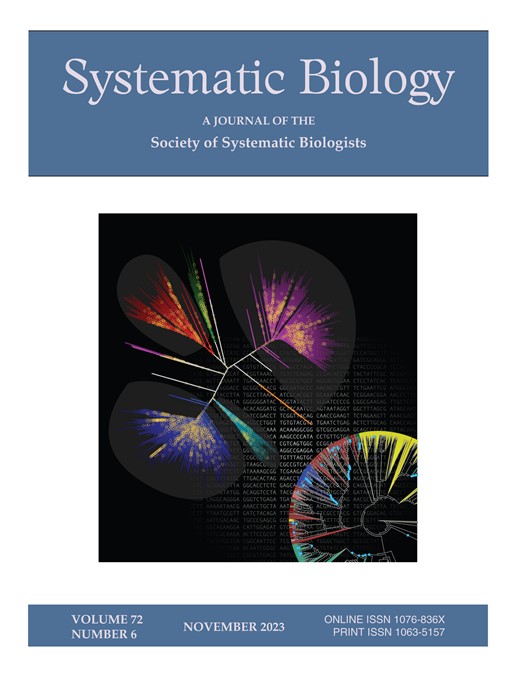蜘蛛的贝叶斯拟态趋近于不准确
IF 6.1
1区 生物学
Q1 EVOLUTIONARY BIOLOGY
引用次数: 0
摘要
贝叶斯模仿是由捕食驱动的趋同进化的一个令人印象深刻的例子。然而,尽管有强大的选择压力,许多模仿者只是在表面上与他们的模型相似,这一观察结果显然是一个悖论。在这里,我们通过对跳蛛族Myrmarachnini (Salticidae)和囊蛛亚科Castianeirinae (corinidae)这两个独立的进化支进行了迄今为止最大的系统发育分析(就分类群和遗传数据的数量而言),验证了“完善假设”,该假设认为不准确的模仿可能代表了宏观进化尺度上的一个过渡阶段。我们发现,精确的蚂蚁模仿在两个进化支系中都是一个渐进的过程,通过整合复合特征,每个特征以不同的速度进化,形成了类似蚂蚁的习性。精确的状态在宏观进化尺度上是高度不稳定的,可能是因为这些特征的强烈表达伴随着高适应成本。相反,推断的全局最优模仿表达处于不准确状态。这一结果将解释的责任从不准确的模仿转向了解释精确模仿的特殊进化和维持,并强调了贝叶斯模仿的进化是由多种相互冲突的选择压力所支配的。本文章由计算机程序翻译,如有差异,请以英文原文为准。
Batesian Mimicry Converges Towards Inaccuracy in Myrmecomorphic Spiders
Batesian mimicry is an impressive example of convergent evolution driven by predation. However, the observation that many mimics only superficially resemble their models despite strong selective pressures is an apparent paradox. Here, we tested the ‘perfecting hypothesis’, that posits that inaccurate mimicry may represent a transitional stage at the macro-evolutionary scale by performing the hereto largest phylogenetic analysis (in terms of the number of taxa and genetic data) of ant-mimicking spiders across two speciose but independent clades, the jumping spider tribe Myrmarachnini (Salticidae) and the sac spider sub-family Castianeirinae (Corinnidae). We found that accurate ant mimicry evolved in a gradual process in both clades, by an integration of compound traits contributing to the ant-like habitus with each trait evolving at different speeds. Accurate states were highly unstable at the macro-evolutionary scale likely because strong expression of some of these traits comes with high fitness costs. Instead, the inferred global optimum of mimicry expression was at an inaccurate state. This result reverses the onus of explanation from inaccurate mimicry to explaining the exceptional evolution and maintenance of accurate mimicry and highlights that the evolution of Batesian mimicry is ruled by multiple conflicting selective pressures.
求助全文
通过发布文献求助,成功后即可免费获取论文全文。
去求助
来源期刊

Systematic Biology
生物-进化生物学
CiteScore
13.00
自引率
7.70%
发文量
70
审稿时长
6-12 weeks
期刊介绍:
Systematic Biology is the bimonthly journal of the Society of Systematic Biologists. Papers for the journal are original contributions to the theory, principles, and methods of systematics as well as phylogeny, evolution, morphology, biogeography, paleontology, genetics, and the classification of all living things. A Points of View section offers a forum for discussion, while book reviews and announcements of general interest are also featured.
 求助内容:
求助内容: 应助结果提醒方式:
应助结果提醒方式:


